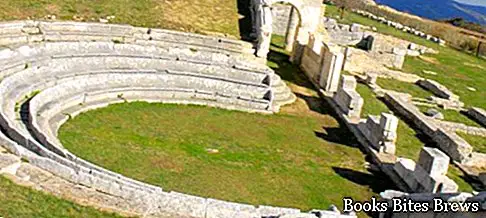What to see in Sepino, an ancient village in Molise, an itinerary including the main monuments and places of interest, including the archaeological area and the Church of Santa Cristina.
Tourist information
Located in an enviable position at seven hundred meters above sea level, immersed in a surrounding landscape formed by verdant woods, Sepino is a famous holiday resort in the Matese geographical area, renowned for its natural beauty.
The remarkable archaeological heritage and the source of the Three Fountains, whose waters have hydropinic and low-mineral characteristics, ideal for the treatment of kidney stones, make Sepino the perfect location for a healthy relaxing holiday.
In Sepino there is no shortage of opportunities to spend free time, which can be spent swimming in the pool, playing bowls and tennis, as well as for relaxing walks on foot or on horseback on the comfortable trekking paths.
The historic center is very interesting, an excellent example of medieval architecture in which, in addition to a large square, there are characteristic alleys, where simple and elegant buildings from the Renaissance period overlook, including the Palace of Bishop Attilio.
The town was once surrounded by a wall belt, having an elliptical shape with four doors, equipped with towers of a castle that collapsed on the occasion of the earthquake that occurred in 1805.
Today you can see some towers and three gates, the South gate, the East gate and the Court gate, also called the Borrelli gate.
What see
The stone fountain, made by local craftsmen, and the Romanesque bell tower of the Church of San Lorenzo deserve attention, with a particular shaped spire made entirely of wrought iron.
Palazzo Giacchi, equipped with a portal from the Roman era, displays coats of arms in stone placed on the portals, as a testimony to the title of dignity, concession or belonging to corporations or trades.
To see the wide staircase leading to the Church of Santa Cristina and the staircase, located on the opposite side, which leads, downhill, to the Church of Santa Maria and Pantano.
The Church of Santa Cristina probably dates back to the ninth century, when it would have been built as a noble chapel attached to the Castle of Sepino, the current entrance portal dates back to the seventeenth century and is dominated by the municipal coat of arms.
Recommended readings- Agnone (Molise): what to see
- Molise: Sunday day trips
- Castelpetroso (Marche): Sanctuary of the Addolorata
- Larino (Molise): what to see
- Isernia (Molise): what to see
Very interesting are the ruins of Terravecchia, which include the remains of the Samnite fortifications of ancient Saipins, whose origins date back to the fourth century before Christ and whose destruction was the work of the consul Papirius Cursor in 293 BC. C.
Other places of interest are the ruins of Saepinum, the Forum, the basilica and the shops.




